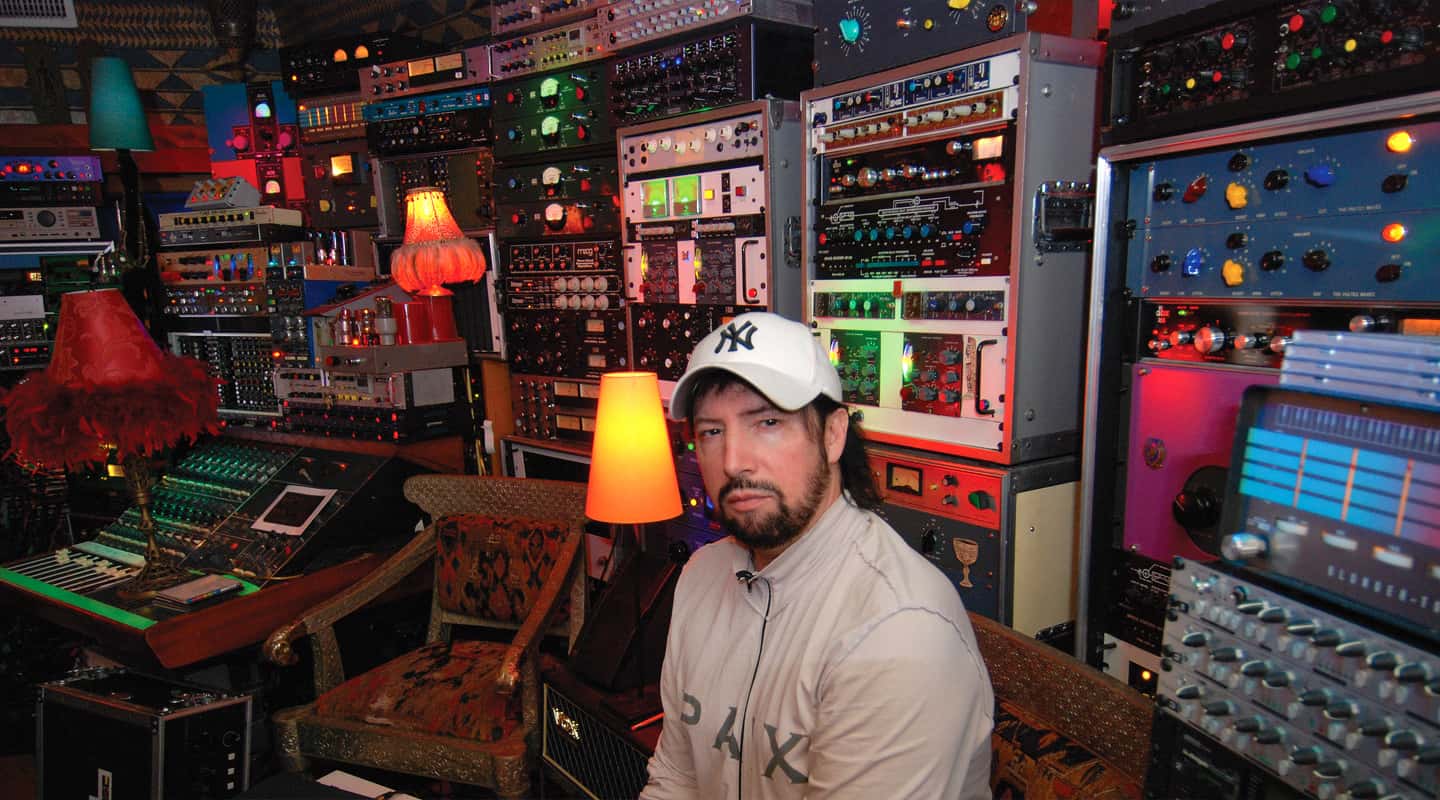
Jack Joseph Puig
Nothing in Jack Joseph Puig’s world is drab; not the console, not the outboard, not the lighting. And as for his mixes, well...
Text: Paul Tingen
“My philosophy is to make records that have a unique sound,” remarks mix icon Jack Joseph Puig. “Too many records sound the same these days, because everyone’s using the same gear. So part of what I’m doing in my mix room is to combine all the analogue gear from the ’50s onwards with the latest digital equipment you can buy today, and mould all that together in a collage to create a record that has its own sound and stands out. If the record is faithful to the song and to the artist, and also has a different aesthetic to what’s normally out there, you really hit a home run. I want records to leave an indelible mark on listeners and I want them to remember the record because it’s great, not because of what I’ve done. That’s an art.”
To say that Jack Joseph Puig has done his fair share of helping a great number of records to make an indelible mark is, to put it mildly, an understatement. The most recent example is the ear-catching, velvety Big Girls Don’t Cry by Fergie, which was riding high in charts around the world this summer. Having spent eight weeks at the top of the US charts, for instance, it promises to become the most successful record of 2007. In addition, in his near three-decades in the business, the Grammy-Award winning mixer has worked with a seemingly endless list of greats, among them The Rolling Stones, No Doubt, all the Crows (Black, Counting, Sheryl), The Verve, U2, Green Day, Snow Patrol, Klaxons, Mary J Blige, and Black Eyed Peas, and steered many of them to the top of the hit parades.
One of the hallmarks of Jack Joseph Puig’s approach is that he goes further than most in enhancing his mixes with what he calls his “strong artistic views”. This reflects a development in recent years in which the role of the mixer has become more and more important. They add overdubs, replace parts or move them around, and change the structure of the songs they’re working on. As a result, many of today’s top mixers can command ‘points’ [a percentage of the song’s revenue], rather than just the flat fee they’ve traditionally received. Puig was a trendsetter of all these developments. He continues to be ahead of the pack by going where most other mixers still fear to tread: directly and radically altering the feel of the musicians that play on a record.
“In this day and age, mixers are no longer dependent on what’s given to them on a hard drive,” elaborates Puig, from his mix room in Los Angeles’s Ocean Way Studios. “The capacities of the tools we now have at our disposal are immense. We can do almost anything at the push of a button, and it’s all non-destructive. The day and age when we threw up the faders and thought, ‘I wish I had this or that,’ are over. It’s massively acceptable now, and even expected, that we add things.
“When I mixed The Rolling Stones’ Bigger Bang album in 2005, I reckoned that one of the songs needed a tambourine and a shaker, so I put it on. If Glyn Johns had done that many years ago, he’d have been shot in the head! Mick Jagger was kind of blown away by what I’d done, no one had ever done it before on a Stones record, but he couldn’t deny that it was great and fixed the record. When I was mixing another song a little bit later he came in and said, ‘Last night I overdubbed a shaker, a tambourine and maracas. I thought that if I didn’t do it, you would.’ It’s a moment I’ll never forget.
“Today people are very open-minded about what we do. It’s a matter of us being worthy of what we’re paid for. It’s about capturing the X-factor, that indescribable element that makes a record great, and sometimes none of us, if we’re honest, know how we got there. You throw up all the faders and you’re looking for a feeling, and suddenly you hit it, and it’s intangible why. Was it the delay? The EQ? I’m extremely lyric-driven, and all I have to help convey what the singer tries to say are two pieces of paper and a magnet that’s moving air. And somehow I have to make you feel sad or happy, or whatever the emotion is, with EQs and compressors. When you think about it, you wonder, ‘how is that possible?’”
How to turn moving paper cones into magic dispensers is the big issue facing anyone working in the studio. Puig’s solution is to focus on feel above everything else. Where most engineers, for instance, use compression to keep levels in check and create a fuller sound, Puig says he exclusively uses the effect to affect feel. “Compression is definitely the most musical tool we have. I don’t care for compression as a volume control. Using compression to alter feel and to affect performances has been done for a long time. For instance, it was common in the ’80s to take a really fast compressor, like the DBX165, set it really aggressively, send a snare drum to it, and then gate that sound as tightly as possible. What you get is a ‘kh-kh-kh’ sound; just an attack note that’s extremely aggressive. You put that under a separate fader, which becomes your attack fader, and you feed that in with the regular snare to get the degree of attack that you want.”
Puig explains that, combined with ProTools’ delay compensation, he can use compressors, both outboard and plug-ins, not only to sharpen the attack, but also to affect the timing of the attack, and therewith change the feel of a performance even more. “You choose the compressor for what you need,” he says. “The way a Fairchild wheezes and moves is very different from the attack of a harder compressor, like an SSL. You can then place the front end of the note where you want, and make the track feel different. A Fairchild will give you a more legato effect, with more sustain, and you find the right place for it in the way that musicians play. So you’re actually playing almost like a musician. This approach played an important part in my mix of Fergie’s Big Girls Don’t Cry.”

MIXING BIG GIRLS DON’T CRY
Artist: Fergie
Writers: Stacy ‘Fergie’ Ferguson, Toby Gad
Producer: will.i.am
Mixed at: Ocean Way Studios in Los Angeles on a customised 80-channel Focusrite console.
First released: May 15, 2006.
UK #2, US #1.
Jack Joseph Puig: “The lyrics are very personal, so I made the record as personal and intimate as I could. Fergie’s vocal performance was so excellent that I didn’t need to pull out all the bells and whistles to make the track work. When I first heard her sing it, it really blew my mind in an, ‘omigod, this woman can sing!’ kind of way. Her performance is just fantastic. The voice is the loudest thing on the record, and it should be. The acoustic guitar is the counterpart to the voice. The record sounds very simple, even though there are a lot of tracks. But it’s not an urban record with heavy kicks and multiple tracks just for the snare, and so on. It’s a pop record, and the heart of the matter is that you can play it on acoustic guitar and voice, and hear the record in your head. That, and an apparent simplicity despite the fact that there’s a lot going on, is the mark of a great record.”
“You have to consider the fact that the ear can only process three things at once. When you get to the fourth thing, the attention drops away somewhere. So if you think about this record, what you remember are Fergie’s voice, the acoustic guitar, and the bass. The acoustic guitar and the voice suck you in and create an indelible memory. They make a stamp in your mind. Her voice – and the delay on her vocals – really draw you into the attitude and atmosphere of the track. It goes back to the X-factor I spoke about. I’m not thinking algebraically, I’m thinking intuitively, creatively, so I can’t justify why I put a certain delay or reverb on the vocal. The acoustic guitar was also very important, it needed to be bright and vibrant and pull you in just like the voice. And I wanted a record that had a nice bottom end so the vocal and acoustic had something to sit on… or rather, ride on.”

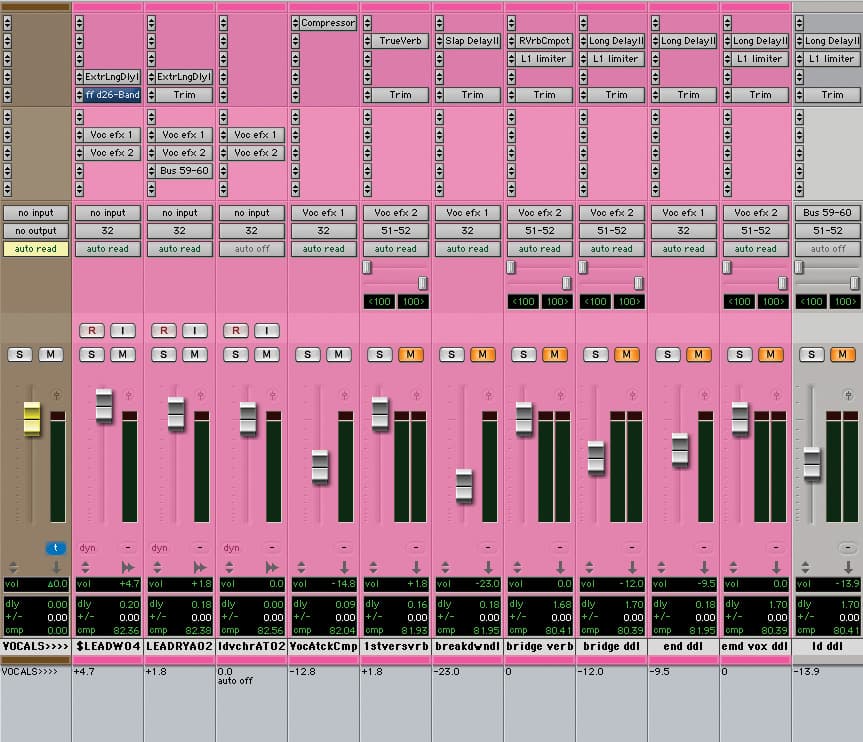
The ‘Guitars’ Mix Window (Top). JJP: “The main guitars are two acoustic guitars recorded in stereo with two microphones – the ones with the purple ‘d’ [$c1str02/$c2str02]. You see the Waves TransXWide plug-in at the top. With this I combine hard compression and short gating to create a sharp transient that I can move about which just helped me to put the guitar further in your face.”
The ‘Vocals’ Mix Window (Above). JJP: The two channels on the left of the ProTools mix window are the actual vocal tracks [$LEADW04/LEADDRYA02], and more to the right you can see that there’s a dedicated vocal channel for each section of the song, so I can create the right feeling from section to section.”
JJP: “…the first verse [vocal]… has its own reverb using a Waves TrueVerb, which is great. The breakdown section has a Digirack Mod Delay II slap delay. There are different ambient feels and different attitudes for different sections. Towards the end, where Fergie’s ad-libbing, I put a longer delay on.”

GUITARS MIX INGREDIENTS
“The main guitars are two acoustic guitars recorded in stereo with two microphones – the ones with the purple ‘d’ [$c1str02/$c2str02 – see Guitar Mix Window top left]. You see the Waves Trans-X Wide plug-in at the top. With this I did what I described earlier; combine hard compression and short gating to create a sharp transient that I can move about. Half a decade ago or so SPL put the effect in a hardware box and later they made a plug-in version, and the Trans-X Wide does the same thing. The only difference is that I can split the effect out over different frequencies. So you can add attack to the bottom end, but not the top end. In the case of the acoustic guitars I found the place where most of the attack was, and then I really grabbed this attack with the Trans-X Wide.”
“If you were to listen to the acoustic guitar without the plug-in, it would sound lazy and lacking in urgency. It doesn’t sound exciting or really dig in. Instead I wanted to give the guitar an immediate attacking, in-your-face sound, as if it’s really digging in and played with fingernails as opposed to the skin of the finger. That’s what the plug-in provided. The brain subconsciously analyses where the front of the note is and what the feel of a record is. If you have attack like this, the recording feels exciting and vibrant, like it’s moving and fast. It’s a large part of the way the record feels. I had the same Trans-X Wide setting on the acoustic guitars throughout the song. It’s actually a preset that I use on various songs. The little red dot shows you that the level is overloaded at 11, so I pushed that plug-in really hard.”
“I also moved the guitar around and placed it right on top of the bar line. An instrument that’s playing right on the bar line will feel faster. So you find the best place by moving instruments around. I’m talking here about a few milliseconds forwards or backwards. So within a bar line you can have brisk eighth notes or lazy eighth notes, and this is a very important tool when mixing. I always try to find the musicians that are playing more slowly and those that are playing more briskly, and move them around until I get the feel I want.”
“The first time I mixed for the Rolling Stones I did a song for Forty Licks (2002), and I remember putting up the faders and thinking: ‘this is a mess, I’m really going to have to spend a day fixing this,’ because timing-wise it was all over the place. I went through that for a bit, and then it hit me like a ton of bricks: ‘you’re looking at this from the wrong perspective. There’s going to be a place where these instruments will fit together and work.’ So I pulled all the faders down again, and then on Friday night at nine o’clock sharp – I still remember the time – I quickly brought the faders up like I always do, and suddenly I hit that magic spot. The way they were all playing together added up to create that Rolling Stones ‘thing’. By contrast, it also happens that you get some songs where everything’s exactly on the grid, and it’s like a drum machine – there is no feel. So you have to move things around to get a feel. But of course, doing that is taking massive musical liberties.”
“The other plug-in on the acoustic guitar is the L1 Ultramaximizer, which just helped me to put the guitar further in your face after it received the treatment I just described. You can see I put the output all the way up to zero. There’s nothing better than an L1 to put things in your face; it will always be the Granddaddy of Waves. So first of all I got the feel of the acoustic guitar right, then I made sure it was very prominent and ‘in your face’. The remainder of the guitars are some strumming guitars on the left, nothing significant, and there are couple of electric guitars, which you can see on the right [Mix Window 1]. They were a little bit clean, and I wanted them to have some more personality, so I ran them through the Stomp 2 [part of Waves GTR Guitar Tool Rack], and I also used [Line 6’s] Echo Farm. The Stomp 2 adds tremelo and vibrato to create a bit of movement in the guitar, and the Echo Farm is set to a delay for a little bit of an ambient feel. As far as outboard on the guitars is concerned, I would have inserted a pair of Gates Level Devil compressors on the board. They are old tube compressors, and they give a big fat sound.”
You have to consider the fact that the ear can only process three things at once. When you get to the fourth thing, the attention drops away somewhere

VOCALS TREATMENTS
“The two channels on the left of the ProTools mix window are the actual vocal tracks [$LEADW04/LEADDRYA02 – see Vocal Mix Window on page 44], and more to the right you can see that there’s a dedicated vocal channel for each section of the song, so I can create the right feeling from section to section. So the first verse [1stversvrb], the bit with just the acoustic guitar backing, has its own reverb using a Waves TrueVerb, which is great. I’ve rolled off above 1K and left all the low end to make it darker and fuller sounding. I’m a Waves guy; they make the best stuff! The D2 gets rid of any dirt below 111Hz and also adds a bit of high end around 12K.”
“The breakdown section has a Digirack Mod Delay II slap delay. There are different ambient feels and different attitudes for different sections. Towards the end, where Fergie’s ad-libbing, I put a longer delay on. The delays change for each section of the song, but the main long delay was essential to how the vocals feel is on the entire vocal, which is why I had it on the main channel. Again, it’s the Digirack Mod II delay, set to 265.49ms.”
“The rest of the vocal effects were all done outside the box. I had a Neve 1073 between ProTools and the console, because I really wanted the sound of that Neve. The closer you can get to the original source with your effect, the more you’ll get the effect you want. If I’d stuck the Neve on an insert in the Focusrite, the signal would already have been coloured by the console, and the Neve sound would have been less obvious. I probably added +3dB at 12K on the Neve and +2dB at 220Hz. After that the vocals went through an Inward Connection TSL3, which is a great vocal compressor that adds great attack. You can get very aggressive with it, and you won’t hear it. I had about 8dB of compression, which is quite a bit, but as I said, you don’t hear it. It made her vocals more expressive.”
BASS
“I used the Trans-X Wide just to sharpen the attack at the lower frequencies, rather than the top frequencies, and also the Oxford Dynamics with one of my own presets, the ‘JJP punch’, which, obviously, is designed to give the bass more punch.”
DRUMS
“When you’re in a mix situation like this, and you’ve worked on other tracks, sometimes your drums sounds become less relevant. Now that you’ve made the vocals and guitar brighter, you might make the snare brighter as well, which is why I added an Aqua snare sample, for instance. There’s a stream of consciousness in mixing this song that’s consistent throughout the entire processing. I again used the Trans-X Wide, with similar duration and release settings as on the guitars and bass, pushing that plug-in hard and overloading it.
“There’s heavy processing on the drums in Big Girls Don’t Cry using both plug-ins and outboard, and as always it was a feel thing. In some places the drums weren’t tight enough, in other places they weren’t long enough. The outboard processing was massive; I could talk for two hours about what I did, it’s that deep. I’m mixing Ashlee Simpson and remixing a Fall Out Boy track at the moment, and I have 17 faders of drum processing, which is normal for me. So it’s really, really deep.”
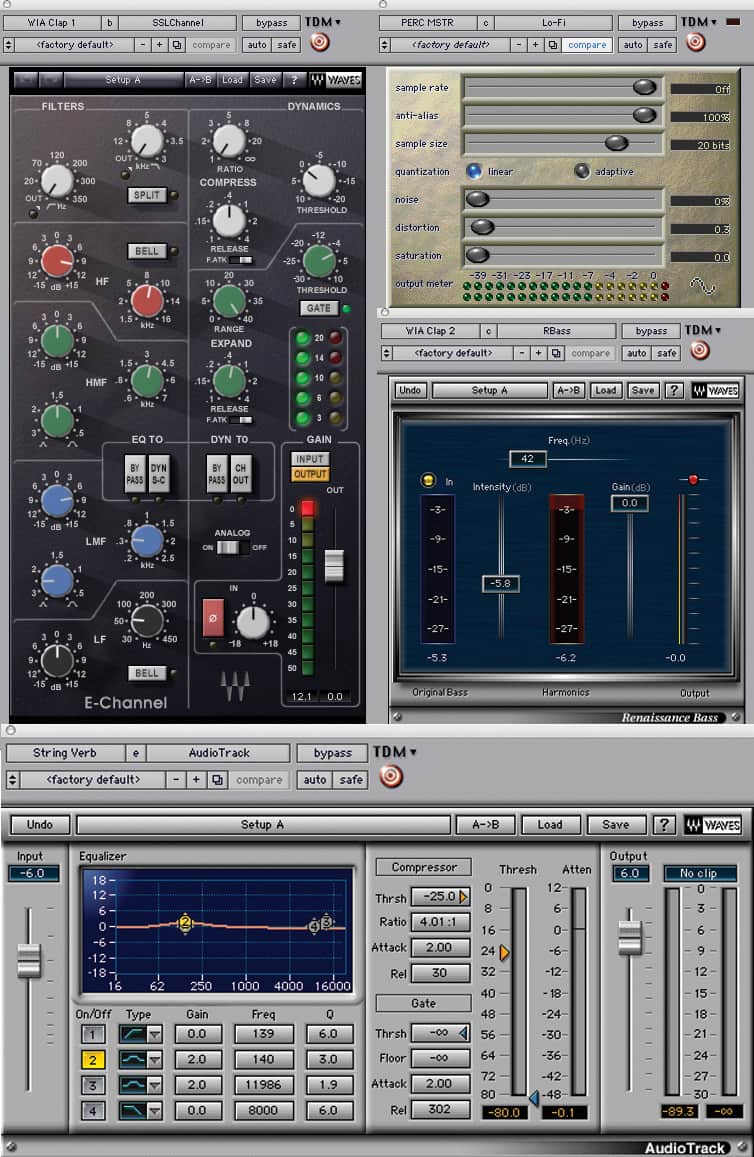
JJP: “There’s a Renaissance Bass on the claps… they functioned like a backbeat and sounded too thin. The TransXWide manipulates the front end of the attacks and gets things to sit well with the acoustic guitar… The SSL channel gated the claps and added a bit of EQ at the same time. I used the Lo-Fi to fatten up the shaker, and the C1 on the tambourine to compress it. The ‘Stringverb’ plug-in is a compressed, manipulated reverb. ‘Audio Tracks’ is a compressor made by Waves that’s fantastic. I love the way it makes things feel”
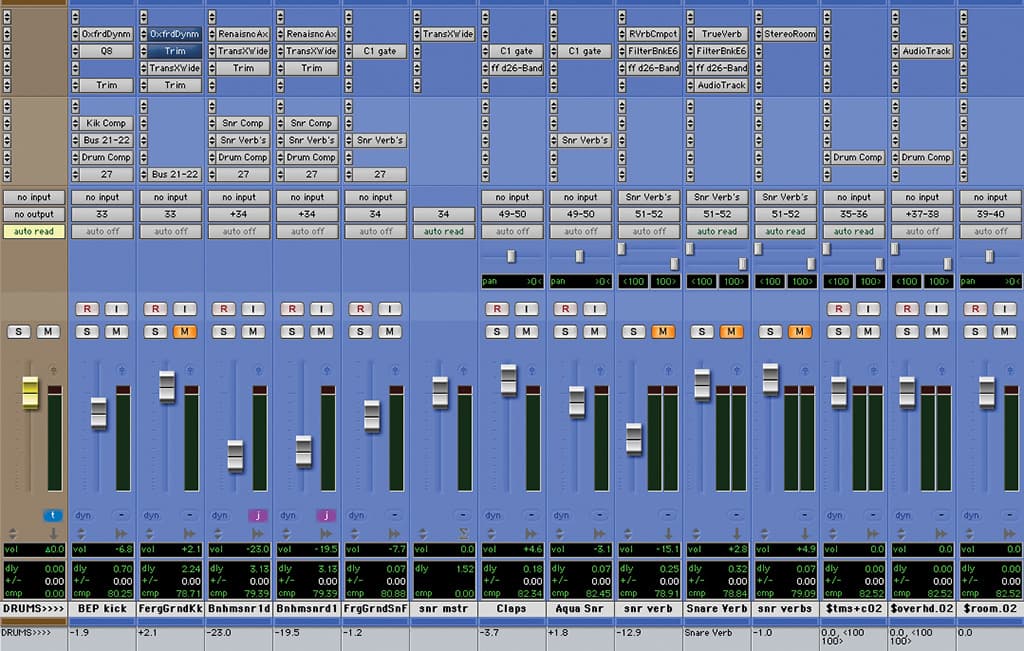
The ‘Drums’ Mix Window. JJP: “Now that you’ve made the vocals and guitar brighter, you might make the snare brighter as well, which is why I added an Aqua snare sample, for instance. I again used the Trans-X Wide, with similar duration and release settings as on the guitars and bass, pushing that plug-in hard and overloading it.”
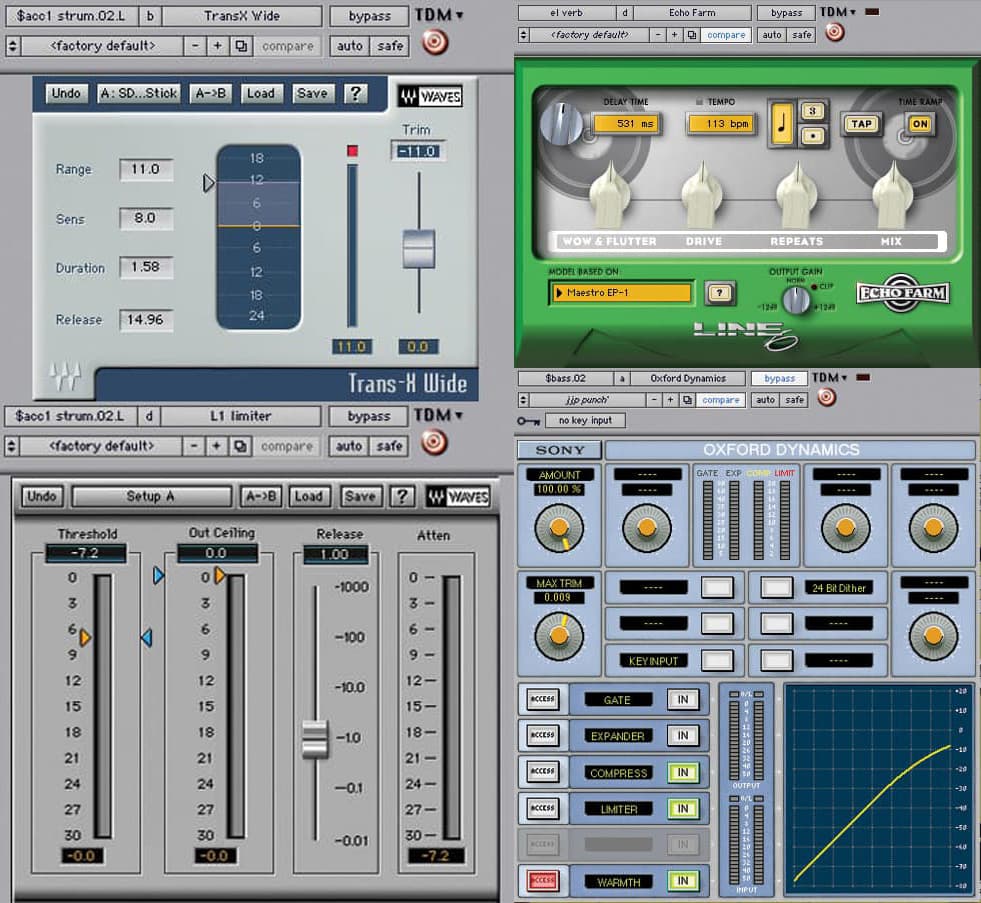
JJP: “The little red dot [on the Trans-X Wide plug-in] shows you that the level is overloaded at 11, so I pushed that plug-in really hard. The other plug-in on the acoustic guitar is the L1 Ultramaximizer, which just helped me to put the guitar further in your face after it received the treatment… There’s nothing better than an L1 to put things in your face; it will always be the Granddaddy of Waves. I used the Trans-X Wide just to sharpen the attack at the lower frequencies, rather than the top frequencies, and also the Oxford Dynamics with one of my own presets, the ‘JJP punch’, which, obviously, is designed to give the bass more punch.”
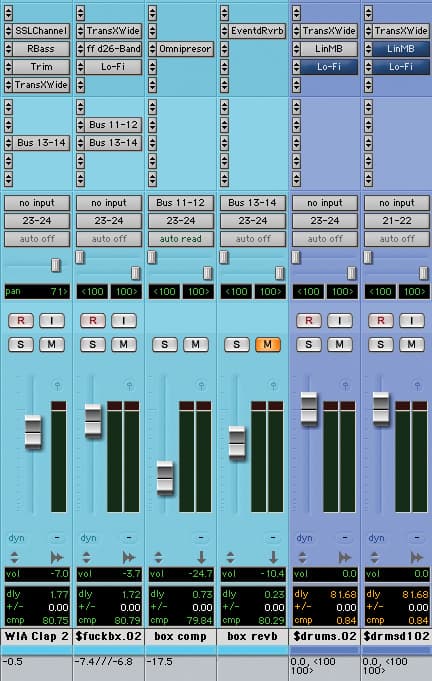
The ‘Loops’ Mix Window. JJP: “The Focusrite provided an EQ on the fuckbox, and there’s an Izotope Lo-Fi plug-in to add a little bit of distortion. That plug-in is fantastic.”
LOOPS TREATMENTS
“All the parts in Big Girls Don’t Cry were programmed in ProTools to enhance the drums. I didn’t add any samples. There’s a Renaissance Bass on the claps on the left; they functioned like a backbeat and sounded too thin. The Trans-X Wide manipulates the front end of the attacks and gets things to sit well with the acoustic guitar. The SSL channel gated the claps and added a bit of EQ at the same time. The fuckbox was a funny bass drum sound [see Loops Mix window on page 50]. The Focusrite provided an EQ on the fuckbox, and there’s an Izotope Lo-Fi plug-in to add a little bit of distortion. That plug-in is fantastic.
“The Omnipressor? That’s a dangerous thing to talk about, and I prefer not to go into it how I used it, because it gets too deep. It used to be a box made by Eventide and was arguably one of the most complex compression/timing manipulators on the planet. There’s been a lot of great equipment that has come into our lives that didn’t take a hold because it was too complex to use. Most users prefer something really simple, like an LA2 where all you have is volume and threshold. The Omnipressor was very complex with lots of knobs, and very off putting unless you were a very technical engineer. The plug-in version has some settings that can give you a really radical kind of compression. I was sending the fuckbox to this via bus 11-12, and it made the sound really aggressive, which I then mixed in. At the bottom, below the faders, you can see that I’m correcting the delays. Now that ProTools has delay correction, you can use some of the additive side of compression that you couldn’t do before.”
PERCUSSION
“There are also shakers and tambourines on the song. I used the Lo-Fi to fatten up the shaker, and the C1 on the tambourine to compress it. Taking out some midrange made it brighter sounding. Then the shaker and tambourine went to the master, and I added Lo-Fi again, to add yet more dirt. The combination of reducing the sample depth to 20-bit, a little bit of distortion made it sound grittier, and the C1 setting added to create the feel I was after.”
KEYBOARDS
“The keyboards are not an important aspect of this song. The most noteworthy thing to point out is the Eventide Factory plug-in on the Fender Rhodes. It was in mono and I used the plug-in to make it wider. I also added aggressive EQ using a Waves Q10 and compressed reverb on a short setting to give the Rhodes a more ambient feel. The idea was just to make sure the keyboard sat well with the guitar and vocals and didn’t get in the way. They’re not affecting the feel, just widening the palette.”
STRINGS
“The ‘Stringverb’ plug-in is a compressed, manipulated reverb. ‘Audio Tracks’ is a compressor made by Waves that’s fantastic. I love the way it makes things feel. The ‘Fairchild’ plug-in is doing what Fairchild does, which is making the notes long and lush and beautiful. The settings don’t really matter. I used the Channel Strip to EQ the midrange. In analogue I used an Eventide 2016 reverb set at stereo room, 3.2s decay time, fronted by a 92 – 110ms pre-delay. I almost always use this setting on strings. Set it to this, and let it rock, there’s nothing better.”







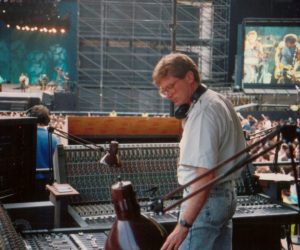








RESPONSES